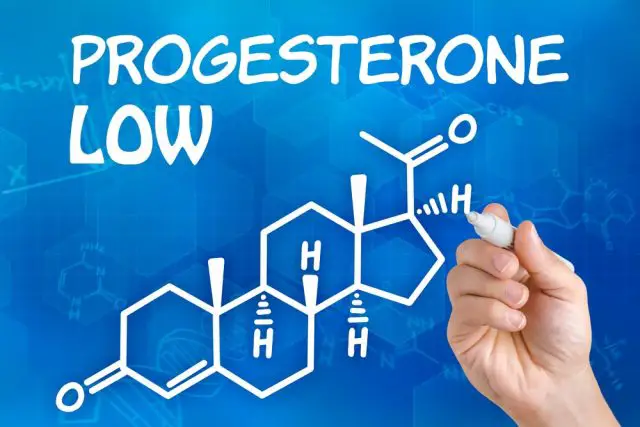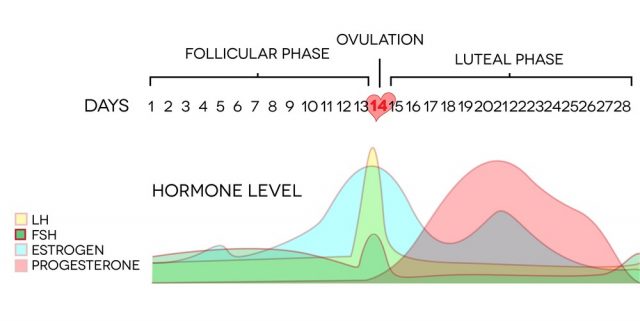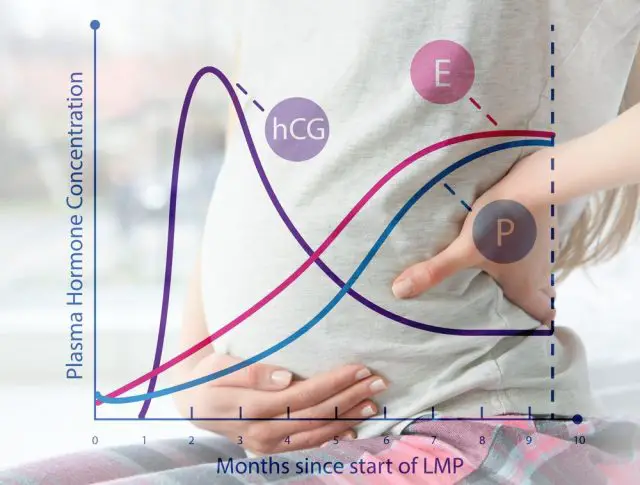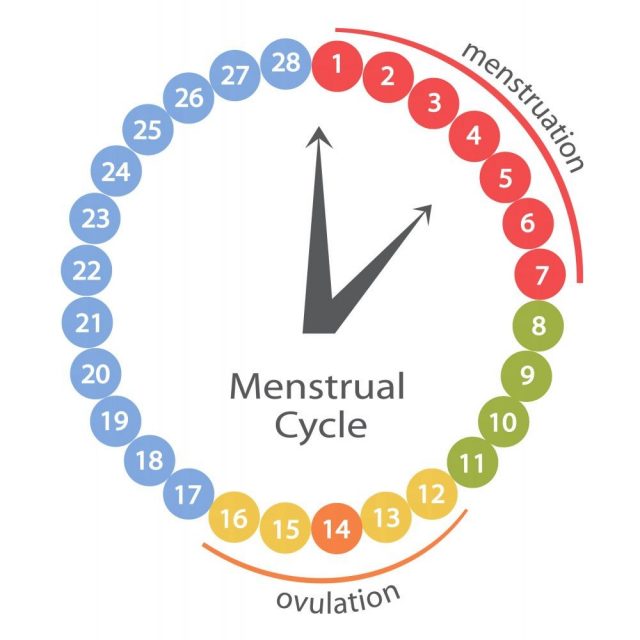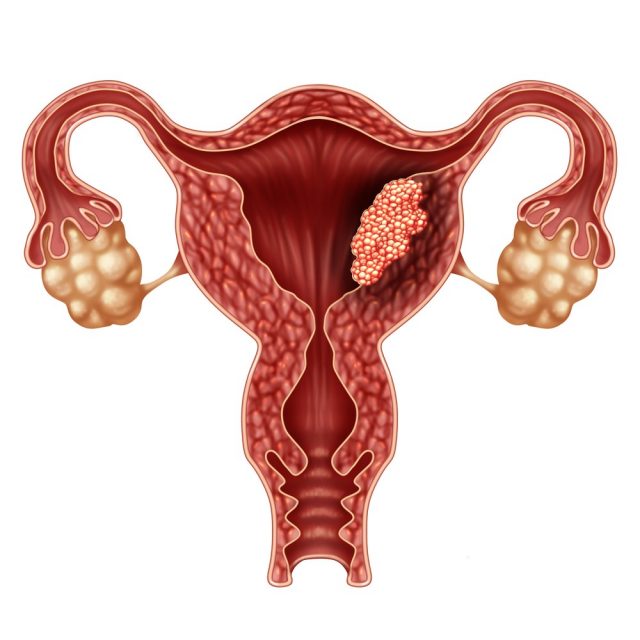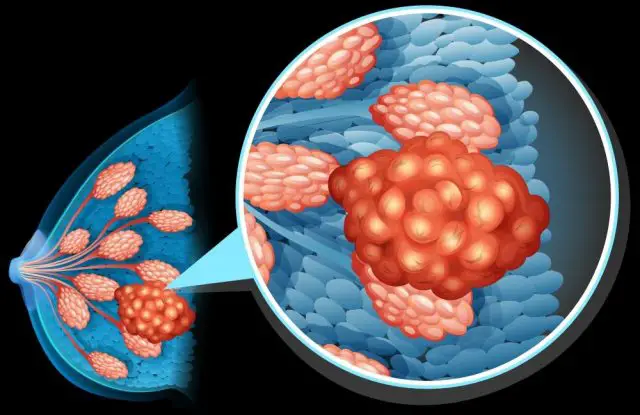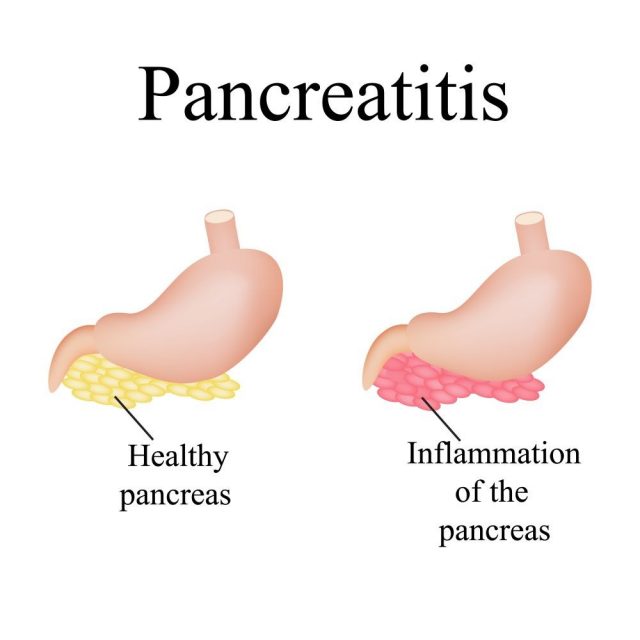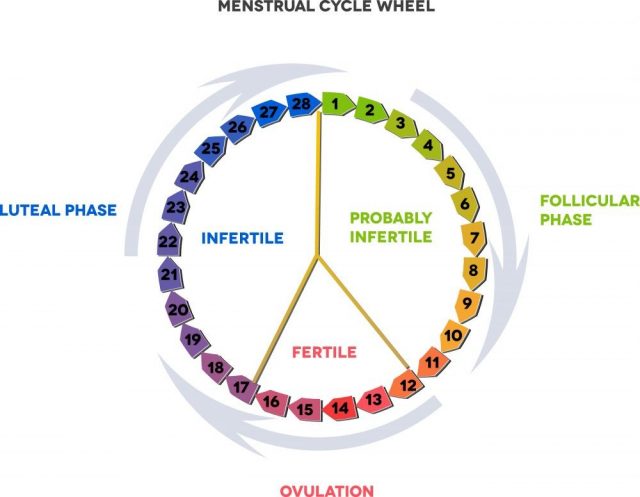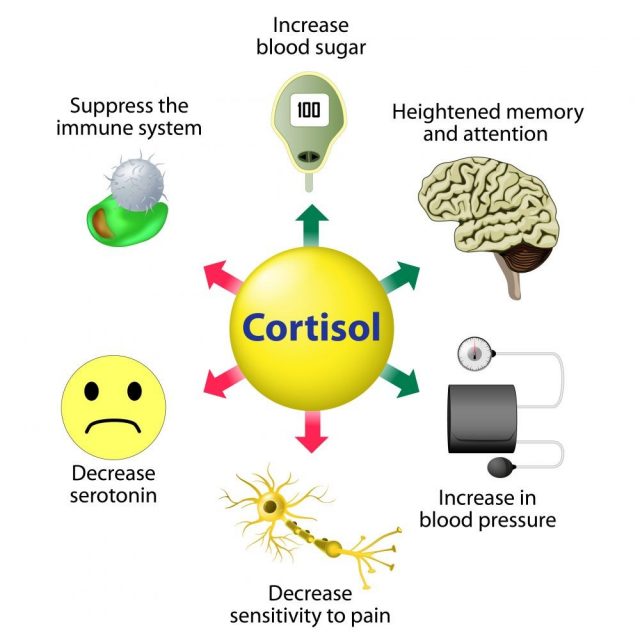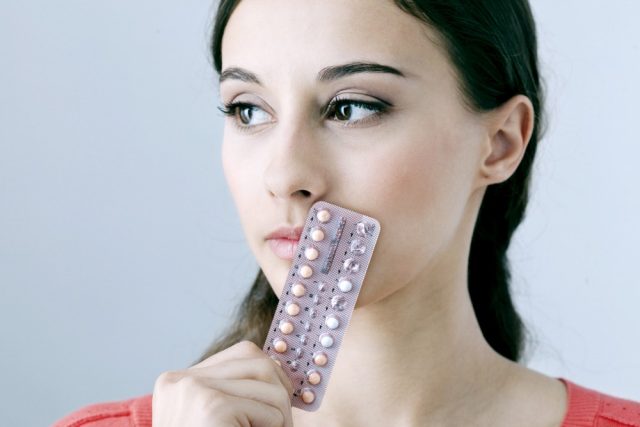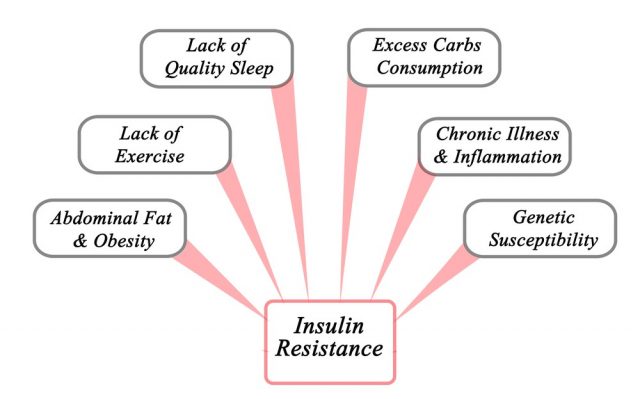Low Progesterone
- What is progesterone and what does it do?
- What does low progesterone mean?
- What happens when there’s high estrogen and low progesterone in the body?
- Symptoms of low progesterone
- How and when can I get my progesterone tested?
- What is the luteal phase and how is it affected by progesterone?
- What causes low progesterone?
- How can I increase my progesterone levels?
What is progesterone and what does it do?
Progesterone is a hormone that controls menstruation and fertility. It is produced by the female body in the second half of the menstrual cycle, after ovulation. Progesterone gets the endometrium ready for pregnancy post ovulation.
It thickens the uterine lining so that the uterus can accept the fertilized egg and impedes muscle contractions so that the body does not reject the egg. When high progesterone is produced, the body does not ovulate. If a woman does not conceive then the progesterone levels drop and the body starts menstruating.
When pregnant, progesterone keeps nourishing the blood vessels in the endometrium so that the baby can be fed. It also prepares the breast for milk production. Progesterone also helps in boosting thyroid function and helps the body use fat for energy. It also has anti-inflammatory effects. Knowledge about progesterone and what it does is important for a woman’s menstrual as well as maternal health.
What does low progesterone mean?
Low progesterone levels lead to abnormal menstrual cycles and may even impede pregnancy as low progesterone will not allow for a good environment for the egg to grow.
Women with low progesterone levels, who do get pregnant, run the risk of miscarriages or pre-mature delivery. Low progesterone levels also cause high estrogen secretion in the body which can cause reduced sex drive, gallbladder problems, weight gain and hair loss.
What happens when there’s high estrogen and low progesterone in the body?
Estrogen and progesterone levels in the body are linked to each other. When estrogen levels are high, progesterone levels are low and vice versa. The two hormones, in balance, affect reproductive fertility. They also affect risk of cancer, bone health and emotional stability.
An imbalance in these can cause serious side effects like the following:
- Vaginal dryness:
 One of the high estrogen low progesterone symptoms is vaginal dryness. Women going through menopause often take estrogen supplements. However, these supplements are known to cause estrogen imbalance and as a consequence, dryness of the skin. This includes vaginal dryness. Stopping these supplements and restoring the progesterone-estrogen balance can stop this dryness and restore the skin to its original, moist condition.
One of the high estrogen low progesterone symptoms is vaginal dryness. Women going through menopause often take estrogen supplements. However, these supplements are known to cause estrogen imbalance and as a consequence, dryness of the skin. This includes vaginal dryness. Stopping these supplements and restoring the progesterone-estrogen balance can stop this dryness and restore the skin to its original, moist condition.
- Endometrial cancer:

Endometrial cancer as a uterus or uterine cancer. Medical concept as cancerous cells in a female body and cervical tumor growth
High estrogen and low progesterone can also cause endometrial cancer. Patients diagnosed with endometrial cancer show symptoms of high estrogen, especially in the uterine lining. This overabundance of estrogen causes DNA damage and leads to cancer. Symptoms of endometrial cancer include pelvic pain and abnormal vaginal bleeding.
- Breast cancer:
Women at the risk of breast cancer exhibit high estrogen and low progesterone in the body. The estrogen-progesterone levels, when altered lead to cancerous mutations of the cells. Many studies show that enhanced periods of high estrogen levels causes cancer cells to fester in the body. Symptoms of breast cancer include discharges and lumps in the breast area.
- Pancreatic damage:
 Women with high estrogen and low progesterone levels often have a high level of triglycerides. These triglycerides form fat that travel through the body and can cause cardiovascular diseases. Thus, over time, high estrogen and low progesterone can cause damage to the pancreas and cause pancreatitis. Symptoms of the disease include vomiting, nausea and upper abdominal pain.
Women with high estrogen and low progesterone levels often have a high level of triglycerides. These triglycerides form fat that travel through the body and can cause cardiovascular diseases. Thus, over time, high estrogen and low progesterone can cause damage to the pancreas and cause pancreatitis. Symptoms of the disease include vomiting, nausea and upper abdominal pain.
- Hair fall:
 Can low progesterone cause hair loss? If that’s what you were wondering, then the answer is yes. Too much estrogen in the body (as a result of low progesterone) can cause the hair to start thinning. Eventually, high levels of estrogen over a period of time, can lead to massive hair loss.
Can low progesterone cause hair loss? If that’s what you were wondering, then the answer is yes. Too much estrogen in the body (as a result of low progesterone) can cause the hair to start thinning. Eventually, high levels of estrogen over a period of time, can lead to massive hair loss.
- Cold hands and feet:
 Low progesterone and high estrogen level inhibit blood circulation. As a result of this your hands and feet may be colder than usual. While there hasn’t been much research to show exactly why this happens, those complaining of these symptoms often exhibit high estrogen levels.
Low progesterone and high estrogen level inhibit blood circulation. As a result of this your hands and feet may be colder than usual. While there hasn’t been much research to show exactly why this happens, those complaining of these symptoms often exhibit high estrogen levels.
- Loss of sleep:
 Estrogen, as a hormone, makes the body more active while progesterone calms the body down. Excessive estrogen and low progesterone thus impedes a person’s ability to unwind and get rest. This can lead to sleep deprivation and in some cases, acute insomnia.
Estrogen, as a hormone, makes the body more active while progesterone calms the body down. Excessive estrogen and low progesterone thus impedes a person’s ability to unwind and get rest. This can lead to sleep deprivation and in some cases, acute insomnia.
- Fatigue:
 This symptom is intrinsically related to the one above. Lack of sleep means more exhaustion and fatigue. A lot of things can lead to exhaustion but if you’re fatigued AND have all of the other symptoms then it is probably because of high estrogen and low progesterone.
This symptom is intrinsically related to the one above. Lack of sleep means more exhaustion and fatigue. A lot of things can lead to exhaustion but if you’re fatigued AND have all of the other symptoms then it is probably because of high estrogen and low progesterone.
Symptoms of low progesterone
For women who aren’t pregnant, symptoms of low progesterone include:
- Migraines and headaches
- Infertility
- Irregular menstrual cycles
- Abnormal uterine bleeding
- Blood clots during menstruation
- Ovarian cysts
- Low body temperatures
- Arthritis
- Allergies
- Brittle nails
- Cracked heels
- Anxiety, depression and mood swings
- Hot flashes
- Hair loss
- Acne
- PCOS
- Endometriosis
- Fibromyalgia
- Gallbladder issues
- Slow metabolism
- Weight gain, especially in the middle section
- Reduced sex drive
For women who are pregnant, low progesterone levels mean that the woman may not be able to sustain the pregnancy and take the baby to its full term. Miscarriages are very common in women who have low progesterone levels.
How and when can I get my progesterone tested?
You can check your progesterone levels by taking a hormone test. But before that, we must understand the very important concept of ‘luteal phase’
What is the luteal phase and how is it affected by progesterone?
The luteal phase is one particular stage of your menstrual cycle. It is the stage after ovulation i.e. when your body releases the egg to before your periods start. It is generally the time when your uterine wall thickens. During the luteal phase, two things occur. First, estrogen boosts the endometrial development, then estrogen and progesterone together create an endometrial environment that is ready for the embryo to thrive. When there is less progesterone in the body, it leads to a shortened luteal phase.
The best time to check your progesterone is the mid luteal phase which means either seven days prior to the expected menses or seven days after ovulation. You are most likely to catch your peak progesterone level at this time. This day varies from woman to woman. Hormone testing can be performed by a naturopathic doctor, by an at-home service or a medical doctor.
The methods to check progesterone are as follows:
- BBT Charting: Basil Body Temperature charting helps verify the level of progesterone present in the body in the luteal stage. Usually there is a steady or slight rise in temperature after ovulation has happened and progesterone has increased. Consistently low or irregular BBT indicates luteal phase defect and low progesterone.
- Length of luteal phase: When the length of the luteal phase is less than 11 days before your period, it suggests luteal phase defects. This indicates low progesterone levels in the body.
- Saliva Hormonal Testing: Saliva testing is another acclaimed method of testing your progesterone. There are “at home” saliva tests that you can take at certain times during your menstrual cycle and then send to a lab for analysis. Some doctors believe that this is the most fool-proof way of testing for progesterone. Even better than blood testing
- Blood Hormonal Testing: This is the most common way of testing for progesterone levels. Blood tests generally allow for all your hormones to be tested at the same time allowing for a comprehensive outline of your entire hormonal system.
What causes low progesterone?
- Stress:
 We all lead very stressful lives and must find a way to control it. High stress levels cause hormonal imbalance and mess with our body’s natural cycle. Stress increases adrenaline and cortisol levels in the body and keeps progesterone low. Cortisol blocks the body’s progesterone receptors which lead to infertility and miscarriages.
We all lead very stressful lives and must find a way to control it. High stress levels cause hormonal imbalance and mess with our body’s natural cycle. Stress increases adrenaline and cortisol levels in the body and keeps progesterone low. Cortisol blocks the body’s progesterone receptors which lead to infertility and miscarriages. - Xenoestrogens:
 Every day we are exposed many environmental estrogens or xenoestrogens that wreak havoc on our body’s hormones. Xenoestrogens cause our body to believe that estrogen levels are high and progesterone levels suffer as a consequence. These are found in plastics, synthetic hormones and animal products.
Every day we are exposed many environmental estrogens or xenoestrogens that wreak havoc on our body’s hormones. Xenoestrogens cause our body to believe that estrogen levels are high and progesterone levels suffer as a consequence. These are found in plastics, synthetic hormones and animal products. - Excessive exercise:
 While exercise is great, too much exercise can cause serious hormonal problems. When women exercise too much to compete at high levels, their progesterone levels come down causing related health problems that are the side effects of low progesterone. The ideal amount of exercise for an active woman should be somewhere between thirty to sixty minutes, four times a week.
While exercise is great, too much exercise can cause serious hormonal problems. When women exercise too much to compete at high levels, their progesterone levels come down causing related health problems that are the side effects of low progesterone. The ideal amount of exercise for an active woman should be somewhere between thirty to sixty minutes, four times a week. - Synthetic hormones:
 Synthetic hormones like progestin cause low progesterone level. Birth control pills and other oral contraceptives contain progestin. Low progesterone birth control pills can cause low progesterone in women. Synthetic progestins block progesterone receptors and that causes progesterone deficiency. Hormone replacement therapy also contains synthetic estrogen that stunts progesterone growth.
Synthetic hormones like progestin cause low progesterone level. Birth control pills and other oral contraceptives contain progestin. Low progesterone birth control pills can cause low progesterone in women. Synthetic progestins block progesterone receptors and that causes progesterone deficiency. Hormone replacement therapy also contains synthetic estrogen that stunts progesterone growth. - Insulin resistance:
 This is a pathological condition where the body is incapable of using the insulin it produces. When the glucose level in the body is too low or too high, the body is unable to absorb progesterone. Foods that cause a spike in insulin levels like carbohydrates and sugar cause the progesterone levels in the body to drop. Insulin resistance often co-exists with other diseases like Polycystic Ovarian Syndrome, diabetes and obesity which further reduce progesterone levels.
This is a pathological condition where the body is incapable of using the insulin it produces. When the glucose level in the body is too low or too high, the body is unable to absorb progesterone. Foods that cause a spike in insulin levels like carbohydrates and sugar cause the progesterone levels in the body to drop. Insulin resistance often co-exists with other diseases like Polycystic Ovarian Syndrome, diabetes and obesity which further reduce progesterone levels.
How can I increase my progesterone levels?
There are many ways natural and synthetic options that can be used for low progesterone treatment:
- Progesterone is synthesized from pregnenolone, which in turn is synthesized from cholesterol. So to ensure high progesterone levels, it is important to change your diet to include foods that give you adequate cholesterol.
- Turmeric can be very useful in boosting progesterone production. Consuming curries with high turmeric content can be very good for your body’s progesterone levels. Other herbs like thyme and oregano also have the same properties. Vitex is also a very important herb to boost progesterone levels. Vitex affects the hypothalamic-pituitary-ovarian axis, thus elevating progesterone levels.
- Eat more foods that are rich in vitamin B, more specifically vitamin B6.
- Follow a diet that is low in conventional meat products as the hormones given to the animals often act as estrogen in the body, reducing progesterone levels. It is best to try organic and grass-fed produce.
- Make sure there’s enough magnesium in your diet.
- Plastics, canned food, beauty products and conventional cleaners contain high levels of synthetic estrogen. Avoiding them can boost progesterone levels in your body.
- Enhance your protein intake. Protein is essential for any hormone production.
- Consume food high in micro-nutrients like vegetable, fruits and leafy greens. Micro-nutrients boost progesterone production.
- Bio-identical progesterone cream can be used as a supplement for low progesterone. However, make sure you read the ingredients of the cream before you start using them. Some creams have high estrogen content along with the natural progesterone so using those will not be helpful to your cause.
- Look after your adrenal glands. When adrenal glands are exhausted due to stress, the body produces cortisol instead of progesterone.
Progesterone levels are very important for a woman’s health. Hormonal imbalances due to low progesterone can cause serious harm to both pregnant and non-pregnant women. Moreover, progesterone allows the embryo to survive and gives immunity to the developing baby.
It also helps keep the body away from many types of cancer and helps regularize menstruation. It is thus important for women to have knowledge about progesterone and progesterone deficiencies. Many women are alien to the concept of low progesterone and heightened estrogen and tend to neglect the symptoms of low progesterone. Symptoms like stress, headache, polycystic ovarian syndrome, endometriosis, hair fall, anxiety etc. are common in our daily lives and hence women tend to ignore them.
However, all of them together often indicate a larger problem. Low progesterone is also known to reduce sex drive, thus affecting your sexual and family life as well. It is therefore important to recognize this disease and nip it at the bud. So, now that you know how, why, when and where to get you low progesterone levels treated- if you have any of the above symptoms, go treat it right away!

